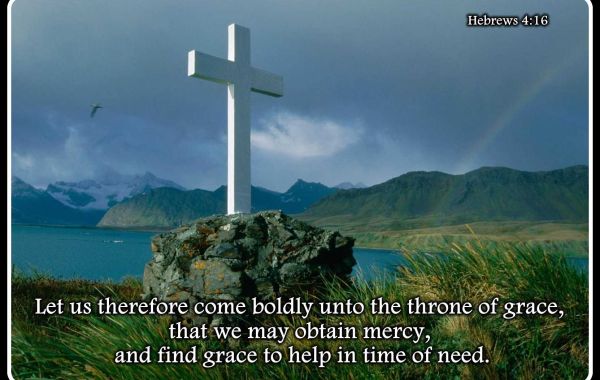The Veil - Exodus 26:31-33
If you were the High Priest of Israel, once a year you would enter into the Holiest of Holies. This, the smallest room, was just past the Altar of Incense and behind a thick veil that divided the two rooms. The veil stretched from wall to wall and floor to ceiling. It contained the same colors as the gate, the red, blue, white and gold that once again point to Jesus.
Different from the outer gate though was the embroidery work of the veil, for woven into the fabric were intricate, and cunning embroidery of cherubim, angels that stood at the entrance of the Garden of Eden and in the Throne Room of God in heaven.
The Room: The Holiest of Holies
The Most Holy Place measured 15' by 15' by 15'. The boards which made up its walls were acacia wood covered over in gold. They were fastened together with rings and rods to form a solid wall. The pillars of the most holy were also covered with solid gold. Entering into the Most Holy Place would be like walking into a room with walls of gold and a ceiling filled with angels. The tabernacle and later the temple were meant to be representations of heaven, and this room was the picture of the throne room of God. Gold which was a symbol of God’s Glory and the weaving of angels completed the picture.
The Ark - Exodus 25:1-22
The Ark of the Covenant stood in the center of the Most Holy Place. It was the most important piece of furniture in all the tabernacle. It measured 2 1/2 cubits long, 1 1/2 cubits wide and deep. It was a box constructed from acacia wood overlaid inside and outside with pure gold. Along the top edge of the ark a crown would go around the box forming a raised rim. A gold ring was fastened to each corner of the ark and a gold overlaid pole would be inserted there for carrying the ark. On top of the ark the mercy seat was placed. This would be the exact dimensions to form a lid upon the top of the ark and it was constructed of solid gold not wood overlaid with gold. Two figures of cherubim, or archangels, one on each end, knelt on top of the mercy seat. They faced each other with their wings spreading up and over the mercy seat itself. Inside the ark, God instructed Moses to place three items, the ten commandments, Aaron's rod and a pot of manna.
The Censor Leviticus 16:12
In addition to the things that stayed inside the Most Holy Place, there was an article that entered into the room with the High Priest on the Day of Atonement. This was a censer used to carry live embers from the Brazen Altar into the Most Holy Place, once inside the high priest would pour finely ground incense upon the embers in the censer. This was to fill the Most Holy Place with smoke, that the mercy seat, where God’s presence dwelt would be hidden. The High Priest would then sprinkle the blood from the offering of atonement upon the mercy seat.
The Surrendered Life
To enter into this stage of maturity and to walk with God at this level, there are 5 aspects of God and my relationship with Him, that I must be aware of.
First, God's Person.
In the Ark of the Covenant, God told Moses to place the tablets of stone that contained the Ten Commandments of God toward His people. These were not the entire code of law, but a compacted, intensified summary of what the full law would spell out in detail. They also were a revelation of God's attributes and character to the Israelites. Through the Ten Commandments they would begin to see who God was.
If I am to ever walk closely with God, I must also know who the character and attributes of God. This knowledge is first glimpsed through the law where I see the holiness and righteousness of God.
When Peter wrote to the early churches he reminded them of God’s holiness and how it must change them. 1 Peter 1:15-16 15 But as he which hath called you is holy, so be ye holy in all manner of conversation; 16 Because it is written, Be ye holy; for I am holy.
Second, God's Providence.
God's providence, His sovereign will put into practice, was symbolized in the ark by the pot of manna. His providence sent the provided, protected and empowered his people then and that same providence provides, protects and empowers His people today.
Notice how Paul revels God’s providence in Philippians 4:11-13. Not that I speak in respect of want: for I have learned, in whatsoever state I am, therewith to be content. I know both how to be abased, and I know how to abound: every where and in all things I am instructed both to be full and to be hungry, both to abound and to suffer need. I can do all things through Christ which strengtheneth me.
That is truly knowing and trusting in the Providence of God.
Thirdly, God's Priest.
Aaron's rod was also kept inside the Ark. This rod was a proof that Aaron and his sons were the family through which God would establish His priests. The rod was an undeniable token of God's will for Aaron to be the mediator of the tabernacle sacrifices.
Hebrews 4:14-16 Seeing then that we have a great high priest, that is passed into the heavens, Jesus the Son of God, let us hold fast our profession. 15 For we have not an high priest which cannot be touched with the feeling of our infirmities; but was in all points tempted like as we are, yet without sin. 16 Let us therefore come boldly unto the throne of grace, that we may obtain mercy, and find grace to help in time of need.
To us as Christians who would enter into the Most Holy Room in our relationship with God, there must be a preeminent concept of Jesus as our High Priest, the mediator of the New Covenant written not on stone this time but upon our hearts. This reality is vital for it brings us to a total dependence upon Jesus as our only means of approaching, dwelling and growing with God. This first occurs at salvation but continues with each day of life, finding through Christ more and more of God's love, grace and peace. I will not have more of God through any of my own abilities, but only as I trust more, learn more, and hold more to Jesus. He is our great high priest.
Fourthly, God's Pardon.
One cannot come to the Most Holy Place without touching on the action that took place here once a year. It was upon the Day of Atonement that Aaron would come with the censor and the blood from the altar of sacrifice. As the smoke of the incense filled the room he would sprinkle blood from the Brazen Altar upon the mercy seat and then upon the ground before the mercy seat.
This is the graphic picture of Jesus pouring out His own life's blood upon the cross before God, that we might receive His righteousness and be reconciled to God. At Calvary was our place of mercy. There we found forgiveness, which by its very nature and cost is so powerful and so complete that it could never be undone nor redone. Once you have found the grace of God you can never lose it any more than Jesus would once again be put to shame on the Cross.
Hebrews 7:25 says, "Wherefore he is able also to save them to the uttermost that come unto God by him, seeing he ever liveth to make intercession for them.
In the Most Holy Place a Christian knows that He does not and cannot lose the forgiveness and mercy given him at terrible cost of the life of the Son of God. The Christian, at this level of living with the Lord, has no more doubts about their salvation, but can now go from strength to strength, from faith to faith because as Psalms 37:23-24 tells us, “The steps of a good man are ordered by the LORD: and he delighteth in his way. 24 Though he fall, he shall not be utterly cast down: for the LORD upholdeth him with his hand.”
God's Presence
The most outstanding characteristic of the Most Holy Place was not the gold, the intricate workmanship of the furniture nor the vail and its embroidered angels. No, it was none of those, it was the presence of God, which dwelt above the mercy seat and between the cherubim. It was God's presence in the room that made it the Most Holy Place. By Him the tabernacle was changed from a tent into a temple. It was made a place of reverence, a place of power and a place of wonder of the majesty of the most high God.
If we are to live in the application of the Most Holy Place, then you have come to a place in your relationship with God, where you can grasp the miracle of the presence of God in your daily living. This is not a manifestation of the Shekinah glory, nor is it a mystical experience or vision, it is the simple acceptance of God's presence in us and the change that must make in us.
David reflects on this in Psalm 139:1-6, 23-24 1 O LORD, thou hast searched me, and known me. 2 Thou knowest my downsitting and mine uprising, thou understandest my thought afar off. 3 Thou compassest my path and my lying down, and art acquainted with all my ways. 4 For there is not a word in my tongue, but, lo, O LORD, thou knowest it altogether. 5 Thou hast beset me behind and before, and laid thine hand upon me. 6 Such knowledge is too wonderful for me; it is high, I cannot attain unto it. … 23 Search me, O God, and know my heart: try me, and know my thoughts: 24 And see if there be any wicked way in me, and lead me in the way everlasting.
This is the powerful presence of God and it is a hallmark of living in the truth of the Most Holy Place. Realize that the presence of God was not left in a tent in the wilderness but through the grace of God, the sacrifice of Christ and the gift of the Holy Spirit, that presence is with us at all times. We walk, live and exist with God in everything we do, everywhere we go, everything we think. That is what living with the Lord really means and how it really can change us.
Until we sit in the real throne room of Heaven with the Father, Son and Spirit the ideal of living at this level, the Most Holy Place level, must remain like the High Priests a time-to-time occurrence. Yet we should long for it, this closer living with and for the Lord.
I can’t help but think of Moses as he stood on top of the Mountain of God once more he asked God, in Exodus 33:18, “I beseech thee, shew me thy glory.”
And the Lord responded as we read in Exodus 33:21-23 And the LORD said, Behold, there is a place by me, and thou shalt stand upon a rock: 22 And it shall come to pass, while my glory passeth by, that I will put thee in a clift of the rock, and will cover thee with my hand while I pass by: 23 And I will take away mine hand, and thou shalt see my back: but my face shall not be seen.”
Moses saw the actual glory of God as He passed by and when he returned to the camp, the Bible says, his face glowed. Exodus 34:29-30 And it came to pass, when Moses came down from mount Sinai with the two tables of testimony in Moses' hand, when he came down from the mount, that Moses wist not that the skin of his face shone while he talked with him. 30 And when Aaron and all the children of Israel saw Moses, behold, the skin of his face shone; and they were afraid to come nigh him.
Moses longed to see God’s glory, to experience more of His presence, and it altered him, the people did not even want to see even the effect of God’s glory. They were afraid to come close and asked Moses to put a vail over his face.
I wonder which people we would be? Would we be as Moses calling out, Oh God, show my they glory! Or would we be with Aaron and the people asking Moses, “Please cover your face because we can’t bear to see what God can do.”
Procurar
popularne posty







